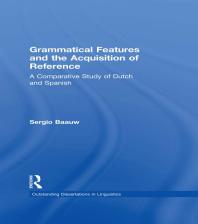

Most ebook files are in PDF format, so you can easily read them using various software such as Foxit Reader or directly on the Google Chrome browser.
Some ebook files are released by publishers in other formats such as .awz, .mobi, .epub, .fb2, etc. You may need to install specific software to read these formats on mobile/PC, such as Calibre.
Please read the tutorial at this link. https://ebooknice.com/page/post?id=faq
We offer FREE conversion to the popular formats you request; however, this may take some time. Therefore, right after payment, please email us, and we will try to provide the service as quickly as possible.
For some exceptional file formats or broken links (if any), please refrain from opening any disputes. Instead, email us first, and we will try to assist within a maximum of 6 hours.
EbookNice Team

Status:
Available0.0
0 reviews(Ebook) Grammatical Features and the Acquisition of Reference A Comparative Study of Dutch and Spanish 1st Edition by Sergio Baauw - Ebook PDF Instant Download/Delivery: 9781136711336 ,1136711333
Full download (Ebook) Grammatical Features and the Acquisition of Reference A Comparative Study of Dutch and Spanish 1st Edition after payment

Product details:
ISBN 10: 1136711333
ISBN 13: 9781136711336
Author: Sergio Baauw
(Ebook) Grammatical Features and the Acquisition of Reference A Comparative Study of Dutch and Spanish 1st Edition Table of contents:
1 The acquisition of pronouns and definite articles Pragmatic and syntactic aspects
1.1 Universal Grammar, modularity and acquisition
1.2 The syntax of definite articles and pronouns
1.2.1 Definite articles and pronouns as instantiations of D
1.2.2 Syntactic constraints on the interpretation of pronouns and DPs: the Binding Theory
1.3 The acquisition of D: the role of underspecification, “rich” morphology, and pragmatics
1.3.1 Underspecification of functional categories
1.3.2 Richness of inflectional morphology and acquisition
1.3.3 The acquisition of reference
Notes
2 Underspecification of the D-position Evidence for expletive determiners in child language
2.1 Introduction
2.2 Non-referential NPs in adult and child languages: previous research
2.2.1 Introduction
2.2.2 Children's interpretation of “home”
2.2.3 VP/IP ellipsis in child language
2.2.4 Complex nominals in children and adults
2.3 “Non-specific NPs” are DPs with expletive determiners
2.4 Complex nominals in child Spanish
2.4.1 Introduction
2.4.2 The experiment
2.4.3 Discussion
2.4.4 Conclusion
2.5 Constructions of Inalienable Possession
2.5.1 Introduction
2.5.2 Binding, incorporation and the role of expletive determiners
2.5.3 Summary
2.5.4 “Rich” agreement and the licensing of expletive determiners
2.5.5 Predictions for language acquisition
2.6 CIPs in child Dutch and Spanish: experimental evidence
2.6.1 The Dutch experiment
2.6.2 The Spanish experiment
2.6.3 Discussion
2.7 Summary and conclusion
Notes
3 The acquisition of pronominal anaphora in Spanish and Dutch
3.1 Introduction
3.2 DPBE as a pragmatics/syntax interface problem
3.2.1 Introduction
3.2.2 Binding and coreference
3.3 The “Clitic Exemption Effect”: the role of inflectional morphology
3.3.1 Introduction
3.3.2 Previous accounts
3.3.3 Dutch weak pronouns
3.3.4 The Dutch weak pronoun experiment
3.3.5 Discussion
3.4 Strong pronouns in Spanish
3.4.1 Introduction
3.4.2 Spanish strong pronouns: Experiment I
3.4.3 Discussion
3.4.4 Spanish strong pronouns: Experiment II
3.4.5 Discussion
3.4.6 Summary and conclusion
3.5 A syntactic DPBE: the role of lexical feature acquisition
3.5.1 Introduction
3.5.2 Previous research: the role of the A-Chain Condition
3.5.3 DPBE in Spanish: experiment I
3.5.4 Discussion
3.5.5 The DPBE in Spanish: Experiment II
3.5.6 Discussion
3.6 Lexical feature acquisition
3.6.1 The role of overgeneralization in lexical feature acquisition
3.6.2 Lexical feature acquisition and economy
3.7 Global economy and computational effort
3.8 Conclusion
Notes
Conclusions
References
Appendix I
1 Experiment Strong Pronouns I & Constructions of Inalienable Possession in Spanish
1.1 Goals of the experiment
1.2 Procedure
1.3 Materials
1.4 Coding of responses
2 Experiment Clitic Pronouns & Constructions of Inalienable Possession in Dutch
2.1 Goal of the experiment
2.2 Procedure
2.3 Materials
2.4 Coding of responses
3 Experiment DPBE I in Spanish
3.1 Goal of the experiment
3.2 Procedure
3.3 Materials
3.4 Coding of responses
3.5 Mean scores
4 Experiment DPBE II & Strong Pronouns II in Spanish
4.1 Goals of the experiment
4.2 Procedure
4.3 Materials
4.4 Coding of responses
5 Complex Nominals in Spanish
5.1 Goal of the experiment
5.2 Procedure
5.3 Materials
5.4 Coding of responses
5.5 Mean scores per condition
Notes
Appendix II
WHeavL-N.2 versions A/C
WHeavL-N.2 versions B/D
Index
People also search for (Ebook) Grammatical Features and the Acquisition of Reference A Comparative Study of Dutch and Spanish 1st Edition:
grammatical features of spanish
grammatical feature example
grammar acquisition order
refers to the grammatical structure of language
a grammatical category
Tags: Sergio Baauw, Grammatical Features, Acquisition, Spanish, Dutch